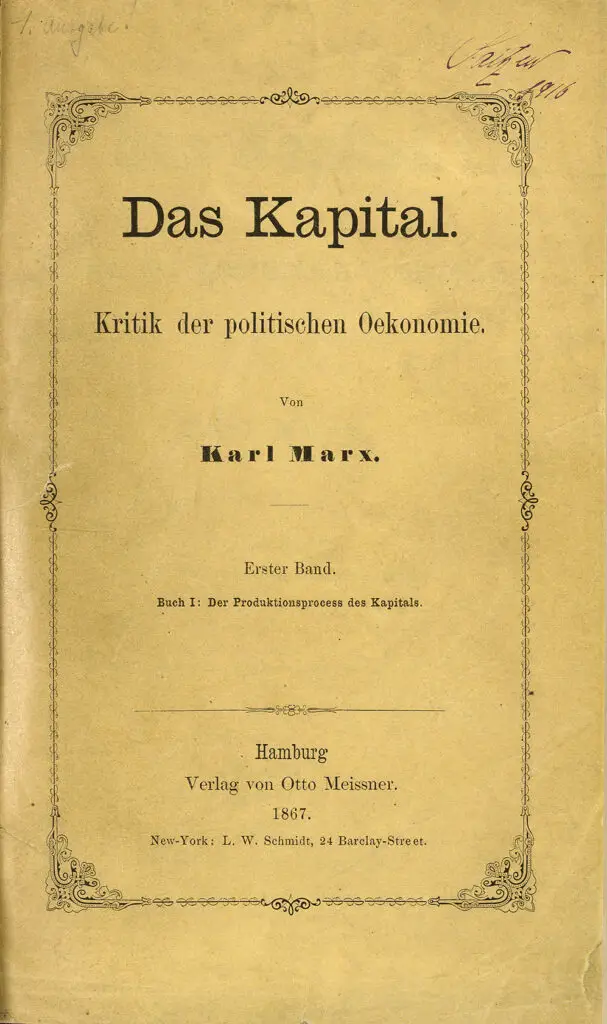Karl Marx’s Capital Volume I: The Process of Production of Capital (1867) is a monumental work that systematically dismantles the capitalist mode of production by exposing its economic foundations, social contradictions, and historical specificity. Through a dialectical materialist framework, Marx analyzes how capitalism transforms labor into a commodity, extracts surplus value from workers, and perpetuates exploitation through the relentless accumulation of capital. The volume’s rigor lies in its methodical progression from the simplest economic unit—the commodity—to the complex dynamics of class struggle, all while grounding theory in historical and empirical evidence.

Major Ideas
Below, we explore the major themes, concepts, and methods in this masterpiece of Karl Marx
The Commodity as the Cell-Form of Capitalism
Marx begins his analysis with the commodity, the “elementary form” of capitalist wealth, to unravel the social relations embedded within seemingly mundane economic exchanges. A commodity, he argues, possesses a dual character: it is both a use-value (an object satisfying human needs) and an exchange-value (a quantitative ratio in which it trades against other commodities). The latter, Marx insists, is not determined by utility but by the socially necessary labor time required for production—the average labor hours needed under prevailing technical and social conditions. This labor theory of value underpins his critique: “The value of a commodity… is a mere congelation of homogeneous human labor,” he writes, emphasizing that human activity, not abstract market forces, is the source of value (Ch. 1).
However, the commodity’s dual nature masks the social relations of production. Marx introduces commodity fetishism to describe how capitalist societies perceive value as an intrinsic property of objects, obscuring the exploitation of labor. “The relations connecting the labor of one individual with that of the rest appear, not as direct social relations between individuals at work, but as… material relations between persons and social relations between things” (Ch. 1). This fetishism naturalizes capitalist exploitation, rendering workers’ subjugation invisible beneath the “fantastic form” of market exchanges.
Labor-Power, Surplus Value, and Exploitation
The pivot of Marx’s critique lies in his distinction between labor and labor-power. Under capitalism, workers sell their labor-power (their capacity to work) as a commodity to capitalists in exchange for wages. The capitalist then extracts surplus value by prolonging the working day beyond the time needed to reproduce the value of labor-power (i.e., wages). For example, if a worker’s daily wage equals six hours of labor but works twelve hours, the surplus labor of six hours generates unpaid value appropriated by the capitalist.
Marx terms this exploitation the secret of profit: “The essential difference between the various economic forms of society… lies only in the mode in which this surplus labor is in each case extracted from the actual producer, the laborer” (Ch. 9). He categorizes surplus value into absolute (lengthening the workday) and relative (increasing productivity via machinery to reduce necessary labor time). The factory system’s rise, exemplified by the British textile industry, epitomizes how capitalists intensify exploitation: “Machinery… becomes the most powerful means for lengthening the working day beyond all natural bounds” (Ch. 15).
This analysis reveals capitalism’s core contradiction: while it socializes production (organizing collective labor in factories), it privatizes wealth, enriching a minority at the expense of the proletariat. “Capital is dead labor, that, vampire-like, only lives by sucking living labor, and lives the more, the more labor it sucks” (Ch. 10).
Accumulation of Capital and the Immiseration of the Proletariat
Marx traces how surplus value is reinvested into expanding production, driving the accumulation of capital. This process, he argues, is not a neutral engine of growth but a mechanism of deepening exploitation and inequality. Accumulation requires a “constant revolution in the means of production” (Ch. 25), as capitalists adopt machinery to boost productivity and outcompete rivals. However, replacing workers with machines creates an industrial reserve army—a surplus population of unemployed laborers—which depresses wages and disciplines the workforce.
The result is a vicious cycle: “Accumulation of wealth at one pole is… accumulation of misery, agony of toil, slavery, ignorance, brutality, mental degradation at the opposite pole” (Ch. 25). Marx illustrates this with harrowing accounts of child labor, workplace injuries, and squalid living conditions in 19th-century England. The capitalist’s drive for profit, he concludes, reduces workers to mere appendages of machinery, alienating them from their labor, products, and humanity.
Historical Materialism and the Rise of Capitalism
Marx grounds his analysis in historical materialism, demonstrating that capitalism is not a natural or eternal system but a product of specific historical conditions. He dedicates a searing chapter to primitive accumulation—the violent process by which feudal common lands were enclosed, peasants dispossessed, and colonies plundered to create a landless proletariat forced into wage labor. “The history of this expropriation… is written in the annals of mankind in letters of blood and fire” (Ch. 26). This “original sin” of capitalism—the theft of communal resources—laid the groundwork for a system where “the capitalist mode of production presupposes the complete separation of the laborers from all property” (Ch. 26).
Marx’s dialectical method shines here, as he shows how capitalism’s “progress” relies on brutality: “Capital comes dripping from head to foot, from every pore, with blood and dirt” (Ch. 31).
Dialectical Method and Revolutionary Conclusion
Marx’s dialectical approach—inherited from Hegel but stripped of idealism—permeates Volume I. He identifies contradictions within capitalism (e.g., socialized production vs. private appropriation) as the engine of its eventual collapse. The central contradiction, between the proletariat and bourgeoisie, is not static but intensifies with accumulation: “The monopoly of capital becomes a fetter upon the mode of production… The knell of capitalist private property sounds. The expropriators are expropriated” (Ch. 32).
This revolutionary conclusion is not a utopian prophecy but a materialist analysis of class struggle. Marx ends with a call to action: capitalism’s grave-diggers—the proletariat—must abolish private property and usher in a socialist society.
Conclusion
Capital, Volume I is a masterful synthesis of economic theory, historical analysis, and revolutionary praxis. By dissecting commodities, labor-power, and accumulation, Marx exposes capitalism as a system built on exploitation, alienation, and violence. His dialectical method—relentlessly tracing contradictions to their logical ends—reveals the inevitability of class struggle and the potential for human emancipation. While critics have challenged his labor theory of value or historical predictions, the text’s enduring power lies in its unflinching indictment of a system that “has conjured up such gigantic means of production and of exchange, [yet] resembles the sorcerer who is no longer able to control the powers of the nether world whom he has called up by his spells” (Ch. 32).


